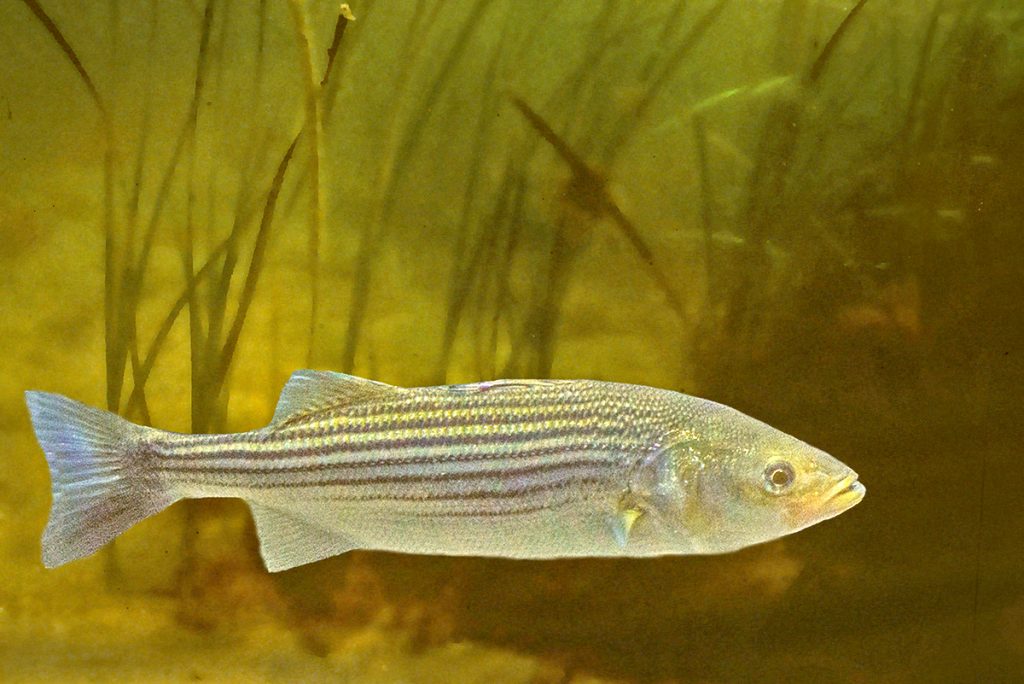
By early April, autumn-bared trees have already begun to spread a new canopy along the banks of the Hudson River. As its waters warm to about 58 to 60 F, striped bass make their way upstream to spawn in the river’s freshwater. Stripers, rockfish, greenhead or linesiders as they are also called, are anadromous fishes; they spend most of their adult lives in the ocean, but head to freshwater to reproduce.

Young stripers frequently swim in schools but large adults tend to be loners, except of course during reproduction. Males arrive first at the spawning grounds while females remain offshore or in an estuary until they are ready to spawn. When a ripe female arrives on the scene, she is soon surrounded near the surface by a group of males that bump up against her as she prepares to release her eggs. In their frenzied activity, the males splash a small geyser at the surface. Their activity is called “rock fights.” Once she has released her eggs, the attentive males release their milt. Fertilization takes place in the surrounding waters. A single female can release 500,000 to 3 million eggs. It is estimated, however, that less than one percent survive as eggs or hatchlings. During their spawning activity, stripers reportedly “eat little or nothing.”
Chesapeake Bay with its rich sources of rivers and streams is host to the greatest numbers of migratory and spawning striped bass along the entire Atlantic coast. It is said that some 70 to 90 percent of Atlantic stripers use the bay to spawn. Many of the adults migrate seasonally but in some rivers such as the Hudson (New York) and Roanoke (North Carolina), a portion of their population also remains year-round in the waterway’s upstream freshwater. In Long Island Sound, the Thames River is believed to be a site of some spawning and there may be a limited amount that occurs in the Connecticut River. However, between April to June, thousands of adult striped bass make their way as far as 30 miles up the Connecticut River to feed on pre-spawned American shad and blueback herring. Many of the juvenile stripers caught near the river’s mouth are believed to originate from the Hudson River. There is no evidence of striper spawning along New Jersey’s coastal areas.
Farther north, Maine’s Kennebec River is also a reproductive site but spawning also occurs even farther north, in New Brunswick and Nova Scotia rivers and even in the St. Lawrence River, Quebec. The species ranges from Canada to St. Johns River, Florida and along parts of the northern Gulf of Mexico (Florida to Louisiana). Some stripers were introduced in Arizona’s Colorado River and at a number of California sites during the 1890s. They now range on the Pacific coast from British Columbia to the United States and Mexico border. Some stripers became landlocked in reservoirs following the construction of dams, while a hybrid form was introduced in some lakes and ponds. First produced in South Carolina by fertilizing striped bass eggs with the sperm of white bass, the hybrids are called Palmetto, wiper or whiterock bass.
Striped bass were an important food source for Native Americans. They were also used to fertilize crops. Early European settlers learned from the Indians about their great taste and agricultural use.
Over the years, the population of stripers decreased due to water pollution, dam construction in spawning rivers and increased commercial and sports fishing. However, implementation of water quality laws and the introduction of state and federal controls for harvesting the fish have greatly improved their numbers.
Typically, stripers live 10 to 12 years, but some make it up to 30 years. Their size depends on where they live. Some grow up to 5 feet, weighing 77 pounds. Females grow larger than males. In the 1890s, several striped bass were taken in pound nets weighing 125 pounds each. The All-Tackle World Record striper was caught by Greg Myerson of Branford, Connecticut. Using a 16-inch live eel for bait, he hauled in a 54-inch long, 81.88-pound prize. At the time, Myerson had been fishing in Long Island Sound, just off Westbrook, Connecticut.
For sports fishermen along the Atlantic coast, striped bass are one of the most popular game fish. Frequently served in Chesapeake Bay area restaurants, it is a delicious food fish that performs a great fight on a rod and reel. Equipped with a broad tail fin, stripers are powerful swimmers and fighters. When hooked, they may splash at the surface and then head for the bottom. It is generally recommended to keep the rod straight up and the line taught after hooking a striper. “If you pull sideways, the fish has an excellent chance of escaping.”
In Long Island Sound, striper action peaks in June through July. If you are trying to catch a large-size striped bass, night fishing is apparently the best time to go after them. Large stripers are nocturnal. The mouth of the Niantic River is often recommended, but so are other rivers along the Sound’s shoreline. When you land one, you will experience the beauty of this fish. It has large black eyes. Its silver-white body is lined with seven to eight horizontal stripes running from its gills to its tail and its scales reflect in sunlight. If it is a keeper and you choose to take it home, enjoy the tasty treat.
From Maine to Virginia, state regulations limit a bag limit for striped bass of one per day. There are also slot limits such as none can be taken that are less than 28 inches in length and not greater than 35 inches. Open season depends on the state. At certain sites in the Chesapeake Bay, regulations only allow catch and release and eels cannot be used for bait. In addition, circle hooks which are curved sharply, are mandated in some states to help prevent them from being swallowed. Federal waters are closed between 3 to 200 miles offshore to all commercial and recreational fishermen. Be sure to check with your own state regulations before heading out.
